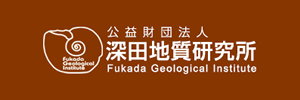Logo
The APC2 logo is designed based on four representative Japanese fossils. The logo was designed by Asuka Sentoku.

Nipponites mirabilis Yabe
A heteromorph ammonoid from the Upper Cretaceous of the North Pacific. This coiling has been theoretically proven to be regular. It is also used as the logo of the Palaeontological Society of Japan.

Lychnocanoma magnacornuta Sakai
Radiolarian Lychnocanoma magnacornuta Sakai is one of the most important age and palaeoceanographic indicators between 7.27 Ma and 12.18 Ma in the arctic North Pacific.

Ginkgoidium nathorsti (Yokoyama)
An extinct ginkoalean species described from the Lower Cretaceous Tetori Group by Dr. Matajiro Yokoyama in 1889. This is one of the first plant fossil species named by the Japanese scientist at the dawn of palaeontology in Japan.

Futabasaurus suzukii Sato, Hasegawa and Manabe
Known as “Futaba Suzuki Ryu” in Japanese, this plesiosaur from Fukushima was discovered by a high school student in 1968. It is one of the symbolic exhibits of the National Museum of Nature and Science, Tokyo.











